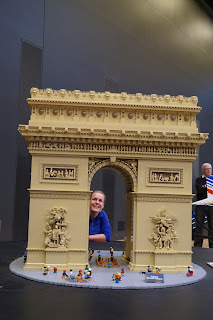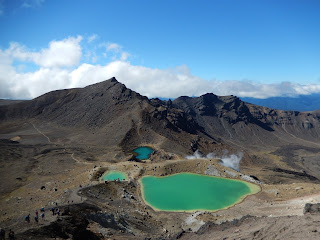We made the short flight from Phnom Penh to Bangkok in less than an hour, which turned out to be significantly less than the amount of time it took to get from Bangkok airport to the city centre. Arriving at our hostel we enjoyed a bit of time cooling off in the air-conditioned room after the heat of the bustling city. That afternoon we took a trip on the Chao Phraya river on one of the water taxis. These are pretty large boats crammed full of tourists and locals as they make their way about the city. It is a great way to see the life of the city from the river and much quicker than taking a trip on the streets. Inside the Wat Pho temple is one of the largest images of a reclining buddha in the world. It is 46m long and completely covered in gold with intricate mother-of-pearl designs on the soles of it's feet. The buddha and the surrounding temple were very impressive.
Fiona with two of the many stupas at Wat Pho
Giant reclining Buddha
After a day in Bangkok we caught a train to the town of Kanchanaburi. This railway is the famous Burma-Thailand Death Railway constructed by Australian & British POWs and Thai labourers during WW2. The train journey was very relaxing sitting by an open window watching the countryside pass by. Our hotel had a lovely pool which was essential for cooling off in the afternoon heat. The following day we caught a taxi from Kanchanaburi to Konyu cutting, which is beyond where the the line now terminates. During construction it was known as Hellfire Pass due to the horrific conditions under which the POWs were made to work and the way it looked when lit up by flaming torches at night. The Japanese forced them to work around the clock doing back-breaking labour with hardly any tools, minimal food and no clean water. Tens of thousands died from malaria, cholera, malnutrition and dysentery amongst other conditions. The Australian government has paid for a museum and memorial to be erected on the site which told the story through photos and an audio-tour narrated by survivors. It was very hard work just walking a couple of kilometers along the track in the intense heat and humidity, so we can't even imagine what those men endured. We recommend the recent book and film 'The Railway Man' which give a good account of what happened here. On the way back to our hotel our taxi dropped us off at the end of the line and we caught a train the rest of the way. This passes over an impressive viaduct and the famous 'Bridge on the River Kwai'.
Hellfire Pass
On the bridge over the River Kwai
Next we headed back to Bangkok for another short stopover where we saw more of the sights and enjoyed dinner near Khao San road, the site of the huge night market. The last major journey of our trip before beginning to head home was on to catch the night train from Bangkok to Chiang Mai in the north of Thailand. The train was brand new and very comfortable. We purchased tickets in the 2nd class sleeper carriage where we had two seats facing each other with a little table. The seats then folded out to make a bed and another bed folded out of the ceiling to make the upper bunk. We had dinner in the restaurant car before being rocked to sleep in our bunks by the motion of the train.
In Chiang Mai we visited a few more buddhist temples with large statues and huge golden stupas (a dome shaped shrine). We also visited the night market here to do some souvenir shopping and enjoy the live music on offer. In nearby Doi Inthanon National Park is Thailand's highest mountain, which conveniently has a road all the way to the top. Unfortunately on the day we chose to do a tour to the park it rained heavily and the mountain was in such heavy cloud that we could only see a few metres in front of us. This meant the impressive King and Queen pagodas near the summit were all but invisible to us. This was very disappointing as it had been the whole purpose of the trip, but as a consolation we stopped at a village on the way down and purchased two beautiful hand-woven scarves.
Golden stupa in Chiang Mai
The highlight of our stay in Chiang Mai was day long cooking class at the Thai Kitchen Cookery Centre. We started the day at the market looking for ingredients and learning about the different spices and vegetables we'd be using. We made green and massaman curry paste then turned them into really tasty curries. We also made spring rolls, chicken satay, noodle salad, pad thai, fried bananas and black sticky rice pudding. The whole day was a lot of fun and we can't wait to put our new recipes and skills into practise back home.
Green curry...yum
Cooking with fire!
Finally after ten days in Thailand and ten months on the road we headed to the airport to catch a plane to Singapore and then home!























































